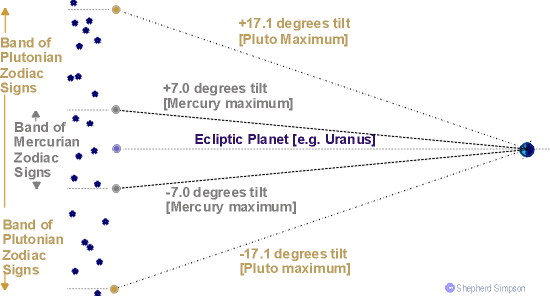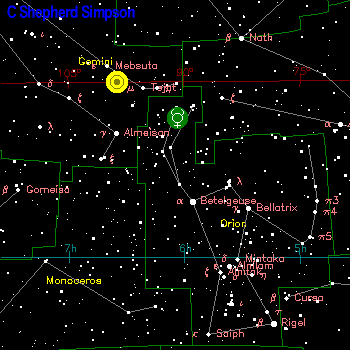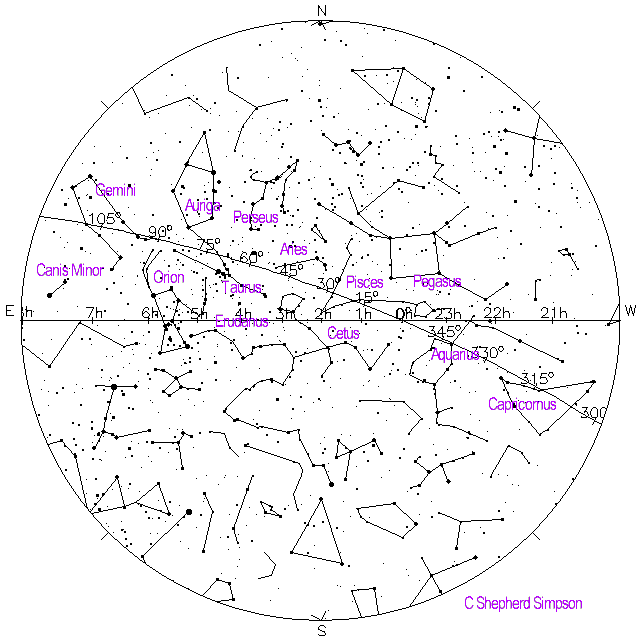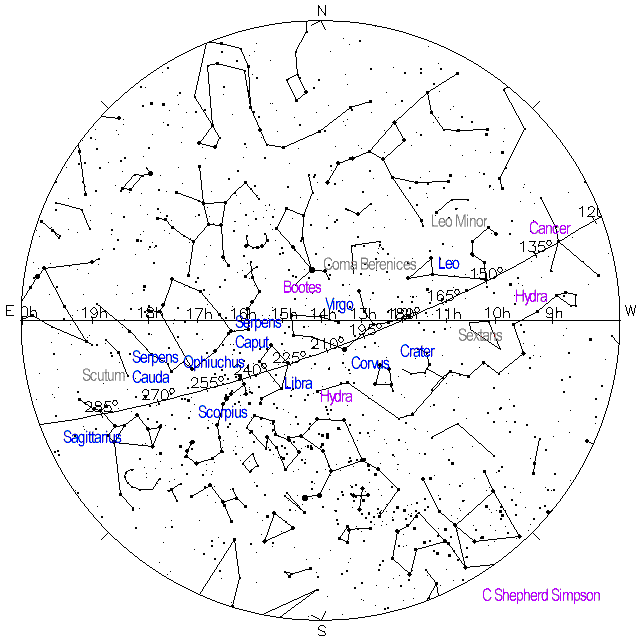The Planetary Zodiac
Definition: [Zodiacs] A band of the heavens approximately 34° wide, centered on the Ecliptic, against which the planets are seen to move, as seen from the Earth. In comparison, the Lunar Zodiac band is 10° wide.
The planet Pluto's path around the Sun is tilted at an angle of approximately 17° to the Ecliptic. This is the maximum orbital tilt of any planet. Hence Pluto, as it orbits the Sun, can be seen, from Earth, against any of the signs of this 34° band.

[Note: the only accurate feature of this drawing is the angles. The planets, stars and the distances are not to scale. Pluto is more than forty times further from the Earth than Venus usually is. And the stars much further still. If the distances to the stars were drawn to scale you would not be able to see the planets. But to illustrate the different width of the zodiac bands, as seen from Earth, all you need to see are the different angles.]
|
The Tilt of the Orbit of a Planet and the Planetary Zodiac: Above is a picture showing the tilts of the orbit of several planets with respect to the Ecliptic. A planet with an orbit tilted by, for example, 7° to the Ecliptic can move above or below the Ecliptic by 7° as seen from Earth. This means it can pass out of the standard Real Solar Zodiac signs, many of which are smaller in extent than 7° each side of the Ecliptic. Uranus has a small maximum tilt, less than 0.8°, therefore its path around the Sun lies almost exactly on the Ecliptic. Hence it passes in front of the same number of stars and signs as the Sun, i.e. the Solar Zodiac 13 constellations. Mercury, however, has a large tilt in its path, a maximum of 7°. Therefore, it passes in front of even more signs than there are in the Lunar Zodiac [the Moon's tilt is 5.0°]. Pluto has a huge tilt, 17.1°. It's zodiac sign band is therefore very large, more than twice that of Mercury's. On the right is a table showing the tilt of the major planets and a number of minor planets in the Solar System. |
A table of the tilt angle of a planet's path around the Sun, in comparison to the Ecliptic. Pluto has the largest and Uranus the smallest orbital tilt of the main planets. The minor planetoids in the asteroid belt can have very large tilts - they will pass through a large amount of the heavens, as seen from Earth. Similarly, the centaur object Chiron has almost the same tilt as Mercury, so it too will be visible against some 20 zodiac signs.
|
How does the Planetary Zodiac differ from the Solar Zodiac? It has many more signs. Because of their orbital tilts, the planets can be found up to a maximum of 17° either side of the Ecliptic. Hence, fairly frequently, they stray out of the thirteen signs of the Real Solar Zodiac into other signs [as does the Moon in the Lunar Zodiac.]
As Pluto has the largest tilt and it can pass in front of 29 signs in the night sky. Mercury and all the others are seen against 20 or less signs.
Examples of the Planetary Zodiac: Below are two examples of the Planetary Zodiac. One star chart is for the planet Mercury in Orion, the Hunter [30 Jun 1994] and the other for the planet Pluto in Serpens Cauda, the Serpents Tail [21 Jun 05].

Mercury in Orion. Start chart for 30 Jun 1994 of the Gemini-Orion-Taurus border in the night sky. The horizontal red line is the Ecliptic. The Sun [in yellow] can be seen against the sign of Gemini, the Twins. The green lines are the constellation boundaries. The white lines join the stars of each constellation to make the constellation figure. Orion is prominent to the right and below centre. Mercury [in green] lies between and below the top two main stars [Χ, Χ²] of the figure of Orion, the Hunter. As seen from Earth, it is just occulting Χ² Orionis. Click on the above picture for a large version.
|
![Pluto in Serpens [Cauda] in the planetary zodiac, June 2005.](images/plutoinserpenscauda21jun05small.gif)
Pluto in Serpens. Star chart for 21 Jun 05 of the Scutum-Serpens-Ophiuchus area of the night sky. The green lines are the constellation boundaries. The white lines join the stars of each constellation to make the constellation figure. Most of the bulk of Ophiuchus, the Serpent Bearer, is visible in the centre right of the chart. By June 2005 Pluto has left Ophiuchus and can be seen against the stars of Serpens Cauda, the Serpents Tail. It is just occulting the star ξ Serpentis. Click on the above picture for a large version.
|
Table of Planetary Zodiac Signs: There are 29 signs in the Planetary Zodiac. However, 4 of these, Coma Berenices, Leo Minor, Sextans and Scutum, are not the original constellations of Claudius Ptolemy, the Father of Astrology. 25 planetary constellations would have been seen by the Classical Greek astrologers.
| Planetary Zodiac Signs | Meaning | Ptolemaic Planetary Zodiac Signs |
| Pisces | the Fishes | Pisces |
| Pegasus | the Winged Horse | Pegasus |
| Cetus | the Whale | Cetus |
| Aries | the Ram | Aries |
| Eridanus | the River | Eridanus |
| Taurus | the Bull | Taurus |
| Perseus | the Hero | Perseus |
| Orion | the Hunter | Orion |
| Auriga | the Charioteer | Auriga |
| Gemini | the Twins | Gemini |
| Canis Minor | the Lesser Dog | Canis Minor |
| Cancer | the Crab | Cancer |
| Hydra | the Water Snake | Hydra |
| Leo | the Lion | Leo |
| Leo Minor | the Lesser Lion | - |
| Coma Berenices | Berenice's Hair | - * |
| Sextans | the Sextant | - |
| Virgo | the Maiden | Virgo |
| Crater | the Cup | Crater |
| Corvus | the Crow | Corvus |
| Bootes | the Herdsman | Bootes |
| Libra | the Scales | Libra |
| Serpens | the Serpent | Serpens |
| Scorpius | the Scorpion | Scorpius |
| Ophiuchus | the Serpent Bearer | Ophiuchus |
| Sagittarius | the Archer | Sagittarius |
| Scutum | the Shield | - |
| Capricornus | the Sea Goat | Capricornus |
| Aquarius | the Water Carrier | Aquarius |
Ptolemy mentions Coma Berenices, Berenice's Hair, in Tetrabiblos, but does not include it as a separate constellation in Al Amagest star catalogue, where the stars are considered part of Leo, the Lion.
Planetary Zodiac Star Charts: Below you can find two Zodiac Charts - covering the whole of the night sky - for the band of the Planetary Zodiac.

Star chart of the planetary zodiac looking towards the Vernal Equinox point. The curved line is the Ecliptic. The horizontal line is the Celestial Equator. Original Classical Greek signs are colored blue.

Star chart of the planetary zodiac looking away from the Vernal Equinox point. The curved line is the Ecliptic. The horizontal line is the Celestial Equator. Original Ancient Greek signs are colored blue. Leo Minor, the Lesser Lion, Sextans the Sextant and Scutum, the Shield, were not constellations recognized by the Greek originators of astrology. Coma Berenices, Berenice's Hair, is not a Ptolemy constellation, though it predates Ptolemy by several centuries and is mentioned by him in Tetrabiblos.
The Zodiac and Astrology:
© Dr Shepherd Simpson, Astrological Historian
Historical Astrology
See the new Astrological Index for the meaning of other astrological words and phrases